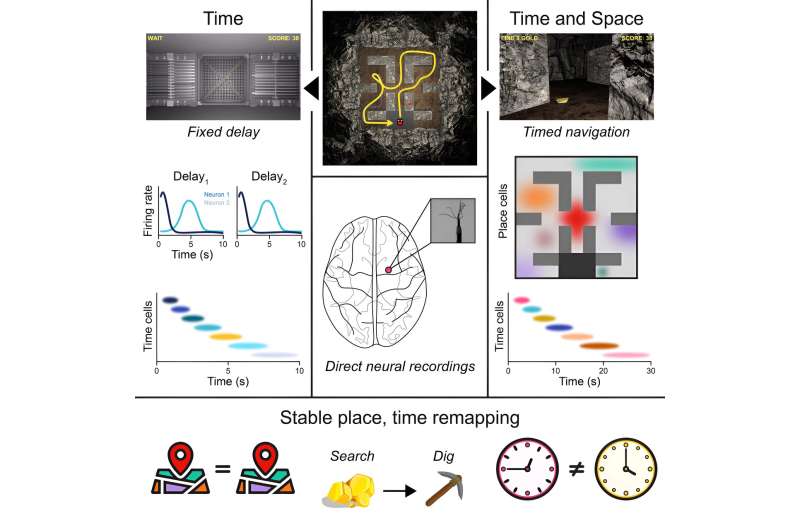This article has been reviewed according to Science X's editorial process and policies. Editors have highlighted the following attributes while ensuring the content's credibility:
fact-checked
peer-reviewed publication
trusted source
proofread
Sets of neurons work in sync to track 'time' and 'place,' giving humans context for past, present and future

Two studies led by UCLA researchers offer new insights into the way neurons in the human brain represent time and space—the most basic ingredients of consciousness of human existence and the primary dimensions of experience that allow us to reconstruct the past and envision the future.
The new findings are based on recordings of the activity of single neurons in the brain, from studies led by Dr. Itzhak Fried, a neurosurgeon and researcher at the UCLA David Geffen School of Medicine, the senior author of two articles in Cell Reports. Patients who had undergone surgical placement of special depth electrodes developed and implanted by Fried for surgical treatment of intractable epilepsy agreed to perform cognitive tasks while their brain cell activity is recorded for these studies.
Neurons that act as the brain's GPS system—termed "place cells" and "grid cells"—were discovered initially in rodents, similar findings later described in humans by Fried and colleagues at UCLA in collaboration with Dr. Michael Kahana, professor of Psychology at the University of Pennsylvania and a co-senior author of one of the new studies. The brain's clock cells, or "time cells," were identified in more recent years.
In one of the new studies, researchers sought to determine how the brain keeps track of both space and time simultaneously.
"To provide an answer, our patients played a timed navigation game where they alternated between searching for and retrieving gold in a virtual gold mine," Fried said.
The researchers, including first author Dr. Daniel Schonhaut and co-author Dr. Zahra Aghajan, first identified "time cells" that activated during waiting periods between the patients' searching periods and retrieval periods. These "at-rest" time cells would activate one after another, as if each was responsible for counting a different second, throughout the waiting period.
During game navigation, separate "place cells" appeared as participants navigated to specific locations in the virtual mine, with a new set of "time cells" appearing at particular points during navigation.
"When patients alternated from searching for gold—a learning phase—and digging for gold—retrieval—place cells remained unchanged, firing at the same locations, while time cells changed. Thus, while temporal and spatial contexts are jointly represented in the brain, they are dissociable, or separable, dimensions at the neuron level," Kahana said.
"This is the first study to demonstrate the coexistence of time and place cells in the human brain," Fried added. "Together, these neuronal classes constitute a biological basis for the cognitive map of spatiotemporal context that we propose comprises the scaffolding onto which memories are written."
In the second study, researchers wanted to understand how the brain keeps track of time during an extended period—a single, continuous episode—like when people are watching a movie with no interruptions.
They wondered if neurons would activate periodically—at recurring time intervals—similar to the way certain spatial neurons fire at spatial intervals when a rodent or human moves through an environment. In spatial situations, a specific set of space-related cells in the brain's entorhinal cortex forms a grid-like map of the environment, where different scales expressed in modulated firing rates provide a metric, or measure, of space at different distances.
To determine if the "periodicity" present in spatial scales can also be seen in the time-axis, the researchers showed 14 neurosurgical patients an hourlong movie while recording single-neuron activity from multiple brain regions. Examination of the firing rates revealed that some units exhibited striking periodicity in their firing over the course of the movie, and the time scale of this periodicity varied from unit to unit, ranging from tens of seconds to several minutes.
Fried said the researchers were surprised to find this unique set of neurons, mostly in the entorhinal cortex, that modulated their activity in such a strikingly periodic manner across time scales that extended to minutes.
"Time within the video could be decoded from the activity of this population of neurons," said Zahra Aghajan, first author of the study also co-authored by Dr. Gabriel Kreiman Professor at Harvard Medical School. "The ability to extract precise, localized, temporal information from this population of cells shows that their periodic activity constitutes a viable mechanism to encode time."
When the participants took a memory test after viewing the movie, many of the time cells changed their dominant timing to shorter time scales, suggesting that these cells may play a role in temporal compression of experience required for memory retrieval. Yet, the relation of these cells to memory performance will need to be explored with further research.
The researchers observed that when the video was presented at two different speeds—regular and sped up—a significant percentage of these temporally periodic cells, or TPCs, maintained their dominant time scales, suggesting a degree of regularity regardless of the audiovisual content.
"Our results suggest that TPCs' temporal periodicity may complement the spatial periodicity of grid cells, together providing scalable metrics for both space and time and enabling the encoding and retrieval of human experience," Fried said.
More information: Daniel R. Schonhaut et al, A neural code for time and space in the human brain, Cell Reports (2023). DOI: 10.1016/j.celrep.2023.113238
Zahra M. Aghajan et al, Minute-scale periodicity of neuronal firing in the human entorhinal cortex, Cell Reports (2023). DOI: 10.1016/j.celrep.2023.113271




















